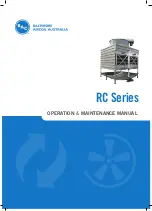
ARTC-SVX001B-EN
41
Controls Interface
Microprocessor Control System
Manhattan™ Gen II Chiller models employ a Carel c.
pCO all-digital data control system to control and
report key system settings and indicators.
Primary Microprocessor Controller
Both the primary and secondary modules use a Carel c.
pCO medium microprocessor controller. The primary
microprocessor controller rotates the lead compressors
every 168 system operating hours. See below figure.
Figure 20.
c.pCO primary controller
Secondary Microprocessor Controller
In a normal configuration, a secondary controller
controls the single module to which it is dedicated. The
distributed primary microprocessor controller system
enables the chiller to operate in the event the primary
microprocessor controller fails. The system
automatically fails-over to distributed primary control
where each secondary controller operates its own
module but lacks the ability to rotate the lead
compressors every 168 system operating hours.
Touchscreen Interface Panel
The touchscreen interface panel is the primary means
for controlling and monitoring the system for the
operator and maintainer. See the following figure.
Figure 21.
Touch interface panel
Operator Control and Monitoring
Each system is provided with a touchscreen interface
panel that is used to turn the chiller on and off, adjust
set points, clear alarms, and perform detailed set-up of
the microprocessor controllers.
Chiller Control
The operator uses three different types of controls and
indicators to monitor and maintain the desired
operating parameters in the Manhattan™ Gen II Chiller.
These controls and indicators are located in the power
panels and the microprocessor controllers.
Power Distribution
There are two different electrical panels used in the
Manhattan™ Gen II Chiller. The main power
distribution panel receives power from the building
source and distributes it to the individual chiller
modules. The module electrical and control panel
receives power from the power distribution panel and
provides power to individual electrical components.
W
WA
AR
RN
NIIN
NG
G
H
Ha
azza
arrd
do
ou
uss V
Vo
olltta
ag
ge
e!!
F
Fa
aiillu
urre
e tto
o d
diisscco
on
nn
ne
ecctt p
po
ow
we
err b
be
effo
orre
e sse
errv
viicciin
ng
g cco
ou
ulld
d
rre
essu
ulltt iin
n d
de
ea
atth
h o
orr sse
erriio
ou
uss iin
njju
urry
y..
D
Diisscco
on
nn
ne
ecctt a
allll e
elle
eccttrriicc p
po
ow
we
err,, iin
nccllu
ud
diin
ng
g rre
em
mo
otte
e
d
diisscco
on
nn
ne
eccttss b
be
effo
orre
e sse
errv
viicciin
ng
g.. F
Fo
ollllo
ow
w p
prro
op
pe
err
llo
occkko
ou
utt//tta
ag
go
ou
utt p
prro
occe
ed
du
urre
ess tto
o e
en
nssu
urre
e tth
he
e p
po
ow
we
err
cca
an
n n
no
ott b
be
e iin
na
ad
dv
ve
errtte
en
nttlly
y e
en
ne
errg
giizze
ed
d.. V
Ve
erriiffy
y tth
ha
att n
no
o
p
po
ow
we
err iiss p
prre
esse
en
ntt w
wiitth
h a
a v
vo
ollttm
me
ette
err..
















































